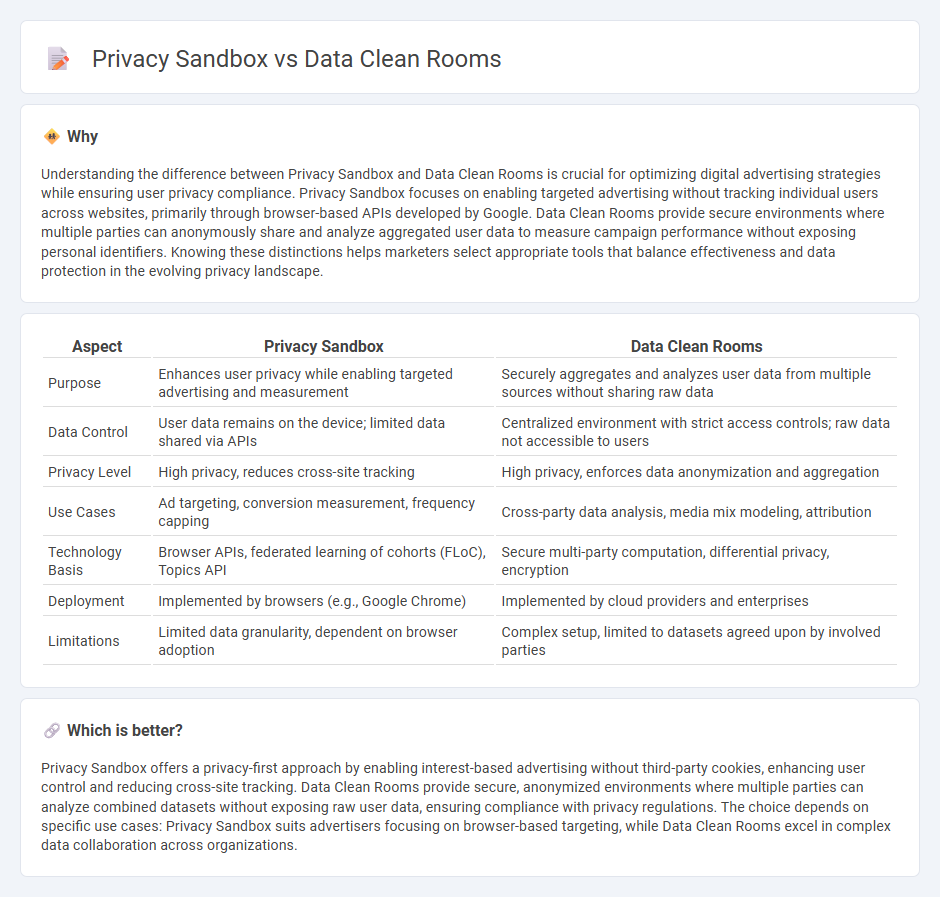
Privacy Sandbox and Data Clean Rooms represent cutting-edge approaches to user data protection in digital advertising, with Privacy Sandbox focusing on reducing third-party cookies while enhancing user privacy through browser-based APIs. Data Clean Rooms enable secure, privacy-compliant data collaboration by allowing advertisers and publishers to analyze combined datasets without exposing individual user information. Explore how these technologies are reshaping the future of privacy-conscious marketing strategies.
Why it is important
Understanding the difference between Privacy Sandbox and Data Clean Rooms is crucial for optimizing digital advertising strategies while ensuring user privacy compliance. Privacy Sandbox focuses on enabling targeted advertising without tracking individual users across websites, primarily through browser-based APIs developed by Google. Data Clean Rooms provide secure environments where multiple parties can anonymously share and analyze aggregated user data to measure campaign performance without exposing personal identifiers. Knowing these distinctions helps marketers select appropriate tools that balance effectiveness and data protection in the evolving privacy landscape.
Comparison Table
| Aspect | Privacy Sandbox | Data Clean Rooms |
|---|---|---|
| Purpose | Enhances user privacy while enabling targeted advertising and measurement | Securely aggregates and analyzes user data from multiple sources without sharing raw data |
| Data Control | User data remains on the device; limited data shared via APIs | Centralized environment with strict access controls; raw data not accessible to users |
| Privacy Level | High privacy, reduces cross-site tracking | High privacy, enforces data anonymization and aggregation |
| Use Cases | Ad targeting, conversion measurement, frequency capping | Cross-party data analysis, media mix modeling, attribution |
| Technology Basis | Browser APIs, federated learning of cohorts (FLoC), Topics API | Secure multi-party computation, differential privacy, encryption |
| Deployment | Implemented by browsers (e.g., Google Chrome) | Implemented by cloud providers and enterprises |
| Limitations | Limited data granularity, dependent on browser adoption | Complex setup, limited to datasets agreed upon by involved parties |
Which is better?
Privacy Sandbox offers a privacy-first approach by enabling interest-based advertising without third-party cookies, enhancing user control and reducing cross-site tracking. Data Clean Rooms provide secure, anonymized environments where multiple parties can analyze combined datasets without exposing raw user data, ensuring compliance with privacy regulations. The choice depends on specific use cases: Privacy Sandbox suits advertisers focusing on browser-based targeting, while Data Clean Rooms excel in complex data collaboration across organizations.
Connection
Privacy Sandbox and Data Clean Rooms both enhance user data protection by enabling privacy-centric advertising and analytics. Privacy Sandbox introduces browser-based tools that limit cross-site tracking while supporting targeted advertising, and Data Clean Rooms provide secure environments where aggregated user data from multiple sources can be analyzed without exposing personal information. Together, they promote compliance with privacy regulations like GDPR and CCPA while maintaining data utility for marketers.
Key Terms
Data Collaboration
Data clean rooms provide secure environments where multiple parties can collaborate on data analysis without exposing raw data, enabling privacy-preserving insights through aggregated and anonymized data sharing. The Privacy Sandbox initiative focuses on replacing third-party cookies with privacy-centric APIs to facilitate targeted advertising while minimizing user tracking and data leakage. Explore how these technologies transform data collaboration by balancing effective marketing strategies with stringent privacy protections.
Differential Privacy
Data Clean Rooms utilize secure environments where user data is anonymized, aggregated, and analyzed to prevent direct access to personally identifiable information, leveraging differential privacy techniques to minimize re-identification risks. The Privacy Sandbox implements differential privacy by adding calibrated noise to data collected on browsers, enabling advertisers to gain insights without exposing individual user identities or compromising confidentiality. Explore how differential privacy shapes privacy-enhancing technologies and balances data utility with user protection.
Attribution
Data Clean Rooms enable secure, privacy-compliant data collaboration by aggregating user-level data without exposing personally identifiable information (PII), providing precise multi-touch attribution for marketing campaigns. Privacy Sandbox, developed by Google, offers privacy-preserving APIs that limit cross-site tracking while enabling aggregated attribution and conversion measurement primarily within the Chrome ecosystem. Explore how these technologies shape the future of accurate, privacy-first attribution analytics.
Source and External Links
What Is a Data Clean Room and How Does It Work? - A data clean room is software that allows brands and advertisers to securely combine first-party data, apply privacy techniques like pseudonymization and noise injection, and use this aggregated data for targeted advertising and campaign measurement without exposing individual user details.
What Is a Data Clean Room? - Data clean rooms provide a secure, isolated environment where multiple parties can collaborate by combining sensitive data with strict access controls, encryption, anonymization, and compliance with privacy regulations such as GDPR or HIPAA.
Share sensitive data with data clean rooms | BigQuery - Data clean rooms enable multiple organizations to share, join, and analyze sensitive data securely without revealing the raw data, supporting use cases like campaign planning, measurement, fraud detection, healthcare research, and supply chain optimization.
 dowidth.com
dowidth.com